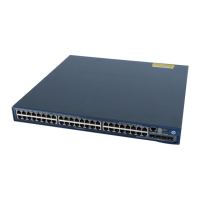84
Figure 22 Rapid state transition of an MSTP designated port
Root port Designated port
Upstream device Downstream device
(1) Proposal for rapid transition
(3) Agreement
The root port blocks non-edge
ports.
The root port changes to the
forwarding state and sends an
Agreement to the upstream
device.
(2) Agreement
The designated port
changes to the
forwarding state.
Figure 23 shows rapid state transition of an RSTP designated port.
Figure 23 Rapid state transition of an RSTP designated port
Root port Designated port
Upstream device Downstream device
(1) Proposal for rapid transition
(2) Agreement
The root port blocks non-edge
ports, changes to the forwarding
state, and sends an Agreement to
the upstream device.
The designated
port changes to the
forwarding state.
If the upstream device is a third-party device, the rapid state transition implementation might be limited.
For example, when the upstream device uses a rapid transition mechanism similar to that of RSTP, and the
downstream device adopts MSTP and does not work in RSTP mode, the root port on the downstream
device receives no agreement packet from the upstream device and sends no agreement packets to the
upstream device. As a result, the designated port of the upstream device fails to transit rapidly, and can
only change to the forwarding state after a period twice the Forward Delay.
You can enable the No Agreement Check feature on the downstream device’s port to enable the
designated port of the upstream device to transit its state rapidly.
Configuration prerequisites
Before you configure the No Agreement Check function, complete the following tasks:
Connect a device is to a third-party upstream device that supports MSTP via a point-to-point link.
Configure the same region name, revision level and VLAN-to-instance mappings on the two devices,
assigning them to the same region.
Configuring the No Agreement Check function
To make the No Agreement Check feature take effect, enable it on the root port.
Follow these steps to configure No Agreement Check:

